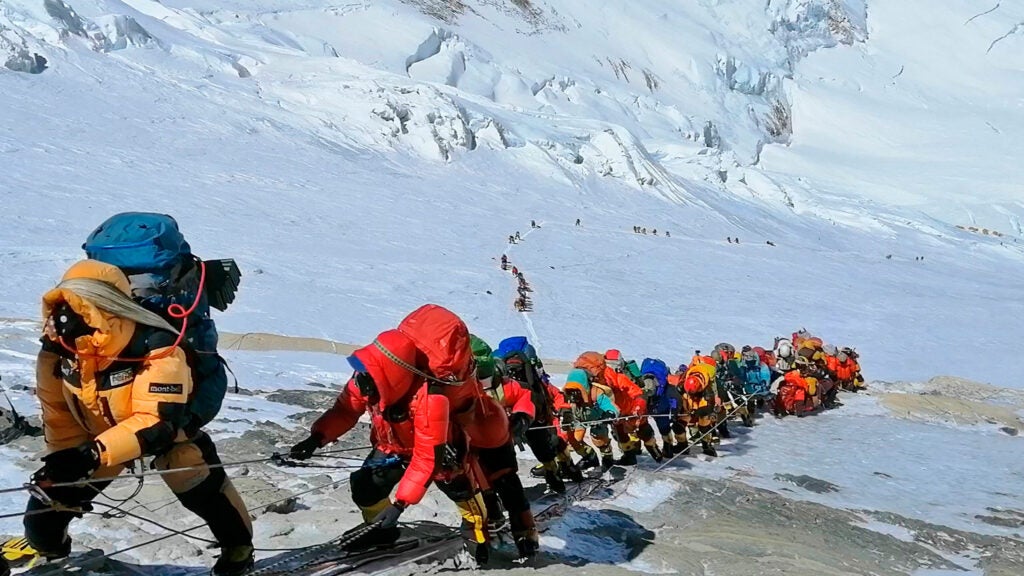No products in the cart.
Outdoor Adventure
Mount Everest Has New Rules for Pooping
Poop it out, pack it down.
That’s the new directive for climbers on Mount Everest this year. On Thursday, February 9, Nepali officials told the BBC that mountaineers ascending the world’s highest peak will have to bring their feces down to Base Camp using plastic wag bags. The rule was instated by the Pasang Lhamu municipality, the local government that oversees much of the Nepali side of the peak.
“Our mountains have begun to stink,” Mingma Sherpa, chairman of Pasang Lhamu rural municipality, told the BBC. “We are getting complaints that human stools are visible on rocks and some climbers are falling sick. This is not acceptable and erodes our image.”
Everest guides who spoke to Outside praised the new policy, while admitting that packing out feces may make their jobs more challenging. “Definitely positive and a long overdue step,” said Austrian guide Lukas Furtenbach.
“The environment on Mount Everest is very important to the climbers,” said Tashi Sherpa, co-owner of the Nepali expedition company Seven Summits Treks. “I do not think it is a problem.”
Both men said rules of this nature are commonplace on other high peaks around the world, like 22,837-foot Aconcagua in Argentina, 16,050-foot Mount Vison in Antarctica, and 20,310-foot Denali in Alaska.
The new rule on Everest overrides the decades-old practice of leaving poop on the mountain, either buried in the ice and rock, or on exposed ground. Expedition operators have traditionally dealt with feces differently at each of the mountain’s five camps, said American guide Ryan Waters of the Colorado-based Mountain Professionals guiding firm. At Base Camp, which sits at 17,598 feet, most climbers use latrines and toilet tents that dot the landscape. Climbers who ascend to Camp I, located at 19,900 feet, often poop into crevasses or dig latrine pits into the Khumbu glacier. At Camp II, located at 20,997 feet, teams build a latrine tent where climbers either poop into a shallow pit or into bags that can be carried down.
“Camp II used to be a real problem, because the stuff would never go away—it just collects in ravines,” Waters said. “In the last few years it’s gotten better because more groups pack it out in bags.”
The situation is more dire at the higher camps, Waters said, because guides and Sherpas have traditionally not wanted to haul feces and garbage down from extreme elevations. Located on the Lhotse face, Camp III, at 23,950 feet, sits on a steep glacier, and teams simply dig shallow holes into the hardened ice. But the real problem is higher up, at Camp IV, at 26,085 feet, on the South Col. The shelf is frozen solid, so you cannot dig into the ground, and hurricane-force winds blow away whatever snow might cover up excrement piles. Climbers don’t want to walk far from their camps in the thin air and violent gusts.
“People just shit on the rocks at the South Col and do not even cover their feces,” Furtenbach said. Waters echoed the sentiment. “Currently, that’s the worst place—it’s a free for all,” Waters said. “Most folks just walk as far as needed until they feel comfortable and go to the bathroom.”
A Nepali group called the Sagarmatha Pollution Control Committee, which monitors the environmental health of the mountain, estimates that there are around three metric tonnes—or approximately 6,600 pounds—of human feces between Camp 1 at 19,900 feet and Camp 4 at 26,085 feet. Half of that amount is believed to be in the South Col, Chhiring Sherpa, the group’s CEO, told the BBC.
Barring a policy change, the amount of feces would only increase. Over the past decade the Nepali government has steadily increased the number of climbing permits for Everest each season. In 2014, journalist Alan Arnette pegged the number of climbing permits for that year’s climbing season at 250. Last year the Nepali government issued 454—the most ever.
Nepal has previously asked climbers to haul their trash down from the peak, and guiding companies have worked with government agencies and even mainstream brands like Coca-Cola to organize cleanup expeditions. How expedition operators will comply with the new rules on poop is yet to be seen. Furtenbach said his company already hauls its poop back to Base Camp. Waters said he would likely ask clients to carry their wag bags down from higher elevations to Camp II, where the bags could be added to a communal trash sack that would be taken down by a guide. Waters has made nine trips to Everest, and Mountain Professionals each year brings between four and seven clients to the peak. “We’re a boutique operator so it won’t be a big lift for us,” Waters said. “The massive groups may have a problem.”
Indeed, Tashi Sherpa said the directive would likely require Seven Summits Treks figure out a new bathroom policy at the higher camps. The company is one of the largest operators on Everest, and in 2023 it brought 100 paying clients and approximately 140 guides and staffers to the mountain. He said that requiring each one of his climbers and guides to haul poop down from higher camps was risky. Instead, he plans to ask the local government if his company can remove feces via helicopter. “We could collect the poop in a drum and then use a helicopter and a long line to fly it down to Base Camp,” he said. If that method was not possible, Tashi Sherpa said he would hire more staffers for waste removal.
“Logistically this means a bigger job for the operator, but I we will find a way to get all of our poop off of the mountain,” he said.
Source link

